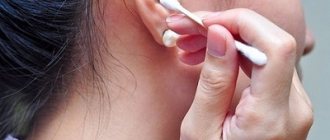15.09.2021
- Why does my ear bleed?
- How to provide first aid if blood appears from a child’s ear?
- Treatment options for bleeding from the ear
- If a son or daughter is sick, parents begin to panic, which prevents them from thinking sensibly. The occurrence of blood from a child’s ear can be eliminated independently without further medical assistance if the child scratches the skin in this area with a fingernail. It is enough to wipe the area of the ear injury with an antiseptic and stop the bleeding. If the situation is more complex, it is important to contact an otolaryngologist as soon as possible.
1.General information
The appearance of blood where it is not intended by nature is in all cases a serious symptom and requires medical intervention. We are, of course, not talking about scratches, donation, regular menstruation in women and other obvious situations; An alarming sign is internal or external hemorrhages (bleeding, hemorrhages), or the admixture of blood in biological substances.
Blood should not flow from the external auditory canal under any circumstances.
Therefore, regardless of how the patient himself feels about this phenomenon (and the reaction in some cases can be completely inadequate, up to anosognosia, i.e. denial of the very fact of the presence of a disease or symptom), contact a doctor, at a minimum, for advice is strictly required.
A must read! Help with treatment and hospitalization!
Diagnosis of the problem
The doctor conducts a tactile and visual examination and, if necessary, performs an otoscopy , which will identify any damage in the ear.
If chronic purulent otitis is suspected, differential diagnosis of epitympanitis from mesotympanitis using X-rays and computed tomography . fluid samples will be taken for analysis. Thanks to research, the doctor can:
- determine the presence of inflammation in the hearing organ;
- identify the exact causative agent of the infection;
- determine the stage of the process;
- find out if there are any complications.
After making a diagnosis, the doctor will prescribe effective medications.
2. Reasons
Bleeding from the ear is considered a relatively rare occurrence, although the possible causes are quite numerous and varied:
- traumatic brain and otoinjuries;
- acute purulent otitis media;
- perforation of the eardrum when cleaning the ears with an object not intended for this purpose;
- barotrauma (during scuba diving, a nearby explosion, a sharp rise in the plane to altitude, etc.);
- spontaneous opening of a purulent abscess in the ear canal;
- tumor processes, benign or malignant;
- polypous hyperplasia;
- foreign body with sharp edges;
- active fungal (most often candida) infections of the ear canal.
Visit our Otolaryngology (ENT) page
How to provide first aid if blood appears from a child’s ear?
If you suspect a traumatic brain injury, place your son or daughter on a flat surface and leave him alone until paramedics arrive. In other cases, you can rinse the damaged area with warm, clean water and treat with an antiseptic composition. Then it is important to make an appointment with an otolaryngologist for the nearest date.
If any object is sticking out of the ear canal, you should not pull it out yourself. Make sure your child doesn't try to do this. Explain to him that the doctor will remove the foreign body himself, and it will not hurt.
3. Symptoms and diagnosis
The main symptom, in fact, is reflected in the title. The amount of blood, depending on the reasons, can vary - from one drop to a noticeable trickle.
Likewise, the color and composition of the discharge may vary - pure scarlet blood, bloody cloudy mucous fluid, pus streaked with blood, etc.
Only an otolaryngologist can establish the causes, assess the degree of danger and prescribe additional diagnostic procedures. In addition to standard otoscopy, radiography, CT or MRI, laboratory smear analysis, and consultations with specialized specialists may be required.
About our clinic Chistye Prudy metro station Medintercom page!
Treatment options for bleeding from the ear
The otolaryngologist's actions depend on how serious the case is. If there is a suspicion of a ruptured eardrum or ear cancer, additional diagnostic tests will be required, including CT and MRI. Additional consultations with a therapist, neurologist, neurosurgeon or oncologist will also be required.
In other cases, the otolaryngologist provides assistance independently. If there is a foreign object in the ear, the doctor carefully removes it and treats the damaged area. If the bleeding is caused by a disease, the otolaryngologist prescribes antibacterial, antifungal, and painkillers. It is important to start treatment as soon as possible to prevent other symptoms from developing. This way, the baby will not experience hearing loss and headaches, so he will be able to recover as soon as possible and return to active games with peers.
4.Treatment
In any case, first aid consists of ensuring the free evacuation of blood and other discharge from the ear canal.
In other words, you cannot pack the ear with cotton, place the patient on his side with the bleeding ear facing up, etc. If there is a risk of infection, use gauze or a bandage, which is applied in several layers to the auricle and bandaged loosely. As a last resort (if medical assistance is obviously not provided soon), instillation of a 0.3% hydrogen peroxide solution into the ear canal is allowed.
It is strictly contraindicated to heat the ear or try to independently remove a foreign body, even if it is clearly visible. Both contraindications apply especially to parents and grandmothers of small children.
In any situation, the first priority is to transport the patient to a doctor as quickly as possible or (depending on the circumstances and general condition) to call an ambulance.
Further therapeutic or surgical strategy is determined by the identified cause of bleeding.
Diagnosis and treatment for ear bleeding
Typically, the first doctor to treat a patient with bleeding from the ear is an otolaryngologist. First of all, it excludes all diseases associated with the hearing aid. To do this, the ear is examined using special instruments, CT and MRI are performed.
Severe otitis media is treated in a hospital with powerful antibiotics or antifungal drugs. Surgical procedures are performed, for example, puncture of the eardrum and its dissection to install a tympanostomy tube, which ensures the drainage of pus and exudate and allows the administration of medications.
Foreign objects are removed using special instruments under local or general anesthesia. The boil is opened in the operating room. If an intracranial tumor is detected, the patient is treated in a neurosurgical hospital. In case of bleeding of unknown cause, hemostatic therapy is carried out before identifying the underlying pathology. The patient is always consulted by a neurologist and neurosurgeon. If necessary, emergency surgery is performed with the participation of several specialists.
If a child has bleeding from the ear, he must be urgently taken to the emergency department of a multidisciplinary hospital.
If blood is flowing from the ear, then you need to remember that the time factor in some injuries determines the prognosis of the disease and the functional state of the hearing aid. Especially if the bleeding is associated with injury or bruise, or rupture of the eardrum.
Causes of nosebleeds
Take a look at this list. Each of the points can cause nosebleeds.
- Overheating of the body;
- Avitaminosis;
- Reduced blood clotting;
- Weak blood vessels;
- Nose injury;
- Inflammatory processes in the nasal passage;
- High blood pressure;
- Pathologies of the cardiovascular system;
- Existing serious diseases, for example: leukemia or anemia;
- Reduced level of platelet production in the body;
- Taking medications;
- The presence of a tumor in the nasal passage.
What could make matters worse?
When trying to stop a nosebleed, certain factors can make the condition worse.
- Blood must not be allowed to enter the respiratory tract. To do this, when lying on the bed, raise the head of the bed with a high pillow. It is also not recommended to throw your head back. The blood must be spat out.
- When lying down, raising your legs leads to a redirection of blood towards the head, and this can provoke a new nosebleed. Avoid this position when stopping bleeding.
- Severe anxiety and drinking tea or coffee increases blood pressure. Try to calm down and avoid drinking these drinks to avoid increased blood flow.
- When the bleeding stops, a crust forms in the nose, which, like a plug, stops the bleeding. If you try to blow your nose immediately afterward, you may bleed again. So, don't rush to blow your nose.
Causes of bleeding from the ears
The ear of a healthy person is designed in such a way that it practically does not require special cleaning. All that can be recommended in terms of ear care is washing the auricle with warm water and baby soap. The ear of a healthy person produces a certain amount of earwax, which has a bactericidal property and protects the inner ear from the penetration of pathogenic microbes. In some diseases, the production of earwax becomes excessive, it begins to spontaneously flow out of the ear, while its bactericidal property is sharply reduced. But even in this case, there is no need to use cotton swabs to clean your ears, since their use will not only be of no benefit, but they will push wax further into the ear, which can cause replenishment of the middle ear.
If you find yourself bleeding from your ears, then first of all, you need to understand the cause of the bleeding. At the beginning, you need to carefully examine the visible surface of the ear, since abrasions and scratches of both the auricle and the external ear canal can lead to minor bleeding. With this type of bleeding, not much blood is released, and when it dries, it forms a crust. All that is required of you in this case is to rinse your ear with warm water and, if necessary, lubricate the abrasion with an antiseptic. If bleeding from the ears is accompanied by symptoms such as ear congestion, ear pain, throbbing pain in the head, then it is possible to assume that you have developed middle ear swelling.
In origin, otitis media can be infectious, viral or fungal etiology. This fact should be taken into account when prescribing treatment for otitis media. So if otitis is of fungal origin, then antibiotics will not help. It is necessary to use antifungal ointments that are placed in the ear. Predisposing factors contributing to the onset of the disease include: hypothermia of the head and ears, prolonged listening to loud music on headphones, infectious processes in the body, swimming in natural bodies of water that do not meet hygienic standards. For any type of otitis, it is advisable to refrain from treatment in the first twenty-four hours, as there is a possibility of spontaneous recovery. In this case, you should rinse the auricle with warm 0.9% saline solution. A good effect can be obtained with the help of heated olive oil; it should be dripped into the ear, 2-3 drops.
If, after a day, there is no relief, you need to contact a doctor, who will prescribe more specific treatment. If you do not carry out timely and complete treatment of acute otitis, then according to the anatomical continuation, the inflammatory process can progress further and lead to complications. In this case, the disease will already be called, and this is much more serious. Unlike simple otitis, when there is no general reaction of the body, in this case there is an increase in body temperature to 38.5 - 40.0 degrees, and malaise. At the same time, on the part of the ear, there is severe pain, with a large amount of pus mixed with blood flowing out of the ear; in the morning, instead of pus, a significant amount of blood may flow out of the ear. And this is not a very favorable symptom, which indicates that the filling of the middle ear has begun to progress and involve deeper tissues.
With such a symptom, there is a high probability of developing a serious brain disease, meningitis. Therefore, if you feel severe pain in the ear, notice bleeding from the ear and that the temperature has risen above 38.0 degrees, you should immediately consult a doctor. To relieve pain, you can use analgesics, in order to facilitate the process, instill warm camphor oil into the ear; among the traditional methods of treating otitis, there is nothing better than badger or bear lard. By dripping this lard into your ear several times, you can forget about otitis media for a long time. Do not forget that purulent otitis media can also occur as an independent disease. This happens from hypothermia, decreased immunity. Bleeding from the ears can occur when formed in two or, this is the replenishment of the hair follicle.
It becomes inflamed when the body's resistance is low, when the defenses are so weak that staphylococci, which are found on the surface of the skin of any person, penetrating into the hair follicle cause its inflammation. In this case, at the beginning of the disease there is only soreness in the ear, but after 2-3 days, you can feel a painful, fluctuating swelling that can periodically bleed. During this period, general changes in the body begin to appear, headaches, increased temperature, both general and local in the ear itself. The ear is swollen, reddened, enlarged. Subsequently, the boil bursts and pus mixed with blood is released from it. General treatment should be aimed at strengthening the body's immunity, reducing body temperature, and relieving pain.
As a local therapy, at the stage when the boil is just beginning to mature, lubricate it several times a day with a solution of boric acid. After the boil opens, remove the accumulated exudate using warm saline. Bleeding from the ear can also occur under the influence of mechanical factors, which can also result in a fracture of the skull bones. A rupture of the eardrum can occur due to careless cleaning of the ear with improvised means, in children while playing, in submariners or people diving from a sudden ascent or immersion under water. A fracture of the skull bones can occur both in an accident and in a blow to the head, or a person, for example, can slip and fall and hit his head hard.
After an injury, bleeding may develop immediately. In this case, there is abundant bleeding, but it may not appear at first. In this case, the victim will feel tinnitus, headache, and dizziness. These signs mean that after the injury, a hematoma began to form in the skull. Which can rupture at any moment and blood will either remain in the skull or flow out of the ear. If ear bleeding of this etiology occurs, under no circumstances should the ear be washed with anything, and nothing should be dripped into the ear. All that is needed is to create complete rest for the victim, place him in a horizontal position, perhaps insert a swab moistened with an antiseptic solution into the ear and urgently call an ambulance.
During long-term use of antibiotics, when treating any disease, candidiasis may occur; it is caused by a yeast fungus of the genus Candida. With this disease, the main symptoms are progressive deafness, itching in the ear and bleeding. For treatment, you need to use antifungal drugs, such as nystatin, levorin, taken orally. For external use, it is possible to use any antifungal ointment, placing it in the ear.
What it is?
Otitis media is an inflammatory disease that occurs in different parts of the auricle and is classified into:
- External - the mildest form of otitis, which is easy to notice, occurs in 25% of people.
- Medium is the most common type of otitis, inflammation of the elements of the tympanic cavity, accounting for about 65% of cases. Diagnosed quite easily.
- Internal - with an advanced stage of an infectious disease from the middle ear, it moves to the internal part, affecting 10% of the population.
It can occur in acute or chronic form.
The acute form of otitis is a severe inflammation that occurs with pain in the ear, which is quickly treated.
Chronic - characterized by a long course of this disease, with periodic inflammations and exacerbations.
Symptoms
From all of the above, it follows that most often, ear discharge in children and adults is caused by the course of a particular disease. The most common causes of fluid leakage from the ear are:
- deterioration of hearing acuity;
- feeling of congestion, pain, ringing, noise and pressure in the ears;
- swelling and pain when touching the parotid or postauricular area;
- the presence of impurities not only with pus, but also with blood;
- the appearance of white flakes of various sizes;
- an increase in the volume of lymph nodes in the cervical, behind-the-ear or submandibular zone;
- increased body temperature;
- runny nose;
- severe headaches and dizziness;
- a liquid with an unpleasant odor that can be felt by both the sick person and strangers. Often the occurrence of such a sign is associated with the course of a purulent process in the ENT organs;
- discomfort in the ear;
- redness of the ear canal;
- sensation of a foreign body in the affected organ of hearing;
- severe itching in this area;
- decreased sensitivity in the affected ear;
- signs of intoxication of the body;
- increasing intensity of pain while eating.
Bloody and purulent discharge from the ear
It is worth noting that such symptoms are the most typical, but in individual cases they can be supplemented by other clinical manifestations inherent in a particular disease that caused the discharge of fluid from the ears.
In addition to the above symptoms, children often experience:
- Changes in behavior - increased anxiety, especially before home ear cleaning. In such cases, children very often cover the ear area with their hand;
- tearfulness in infants and complaints of ear discomfort in older children.
Etiology
Diseases in which fluid leaks from the ear:
- Burst eardrum
- External otitis develops as a result of the penetration of bacteria under the skin in people who have microtraumas of the ear cavity. Such damage can be caused by overuse of bathing procedures, frequent swimming, skin diseases, and the use of improvised means and cotton swabs to clean the ears. Earwax is washed out of the ear, its protective function is weakened, and the body's resistance is reduced. Otitis externa manifests itself as hyperemia, itching, ear pain, and hearing loss.
One of the symptoms of otitis media is also otorrhea. In this case, purulent fluid usually flows from the ear. Otitis can be acute, accompanied by fever, and sluggish with a temporary cessation of symptoms. The acute form is manifested by pain, unpleasant sensations in the ear, and decreased perception of sounds. The sluggish form is characterized by the disappearance of clinical signs and their reappearance. In the absence of timely treatment, inflammation from the tympanic cavity spreads to the inner ear, and labyrinthitis develops.- Violation of the integrity of the eardrum is caused by an acute inflammatory process, traumatic injury, foreign bodies, and high pressure when diving to depth. A torn membrane ceases to perform protective and sound-conducting functions. Patients develop otitis media, hearing loss, and serous fluid flows from the ear.
- Mastoiditis is an inflammation of the cellular structures and cave of the mastoid process of the temporal bone, located behind the ear and containing air-filled bone cavities. The disease is manifested by suppuration, redness of the ear, peeling and itching. Local hyperthermia and tissue swelling are signs of inflammation. Common symptoms of mastoiditis are headache and fever.
- Furunculosis of the ear develops against the background of microbial exposure and is observed in people with a hereditary predisposition. Purulent boils in the ear canal cause pain that increases with chewing. The boil is visible to the naked eye if it is located shallowly. When it ruptures, pus flows from the patient's ear.
- Watery discharge from the ears is observed with allergic otitis media. The disease develops in response to various irritants - allergens. Transudate begins to be actively synthesized, which accumulates in the middle ear and, after perforation of the membrane, comes out. Allergic otitis media is a common manifestation of general allergization of the body. The flow of colorless fluid from the ears is accompanied by itching and congestion. Antihistamines will help get rid of such symptoms.
- Cholesteatoma is a tumor of the epithelial cells of the middle ear. It can be congenital and secondary or acquired. Cholesteatoma develops after chronic inflammation or trauma to the ear structures. Patients with a tumor complain of dizziness, a feeling of fullness or pressure in the middle ear, headache, nausea, loss of performance, and severe fatigue. The pathology is manifested by a flow from the ear with a sharp, unpleasant odor and constant pain. In severe cases, patients lose their hearing and may become completely deaf.
- Ear dermatitis is accompanied by profuse drainage from the ear. The affected ear hurts greatly, the external canal swells. Patients complain of unbearable itching, swelling and flaking of the skin, the formation of weeping wounds, flowing pus and sticky liquid.
- Otomycosis is a fungal inflammation of the hearing organ, which develops as a result of long-term use of hormones or antibiotics. The disease is manifested by itching, white discharge with a yellowish or greenish tint. To treat fungal otitis, antimycotic drops are used.
- TBI is often accompanied by a rupture of the dura mater and leakage of cerebrospinal fluid from the nose and ears, which has a watery consistency and a transparent color. This is an emergency condition that requires immediate medical attention.
- Untreated ARVI often spreads to the hearing organ. With influenza and ARVI, body temperature rises, runny nose, sore throat and ears, and general signs of intoxication. In the absence of adequate treatment for a respiratory infection, hearing acuity will gradually decrease until the ability to perceive sound is completely lost.
- Adenoids in children, sinusitis , tonsillitis also affect the condition of the middle ear.
Leakage of fluid from the ears is one of the main symptoms of ear pathology. It is often combined with the following symptoms: fever, chills, hearing loss, dizziness, regional lymphadenitis, shooting ear pain, hyperemia of the auricle.
Other causes of otorrhea include the following:
- Hypothermia.
- Intense and harmful effects of tobacco products.
- Contaminated water entering a swimmer's ear.
- High air temperature and high humidity.
- Improper ear cleaning, damaging the outer ear.
- Wearing hearing aids.
- Genetic predisposition.
- Immunodeficiency states.









